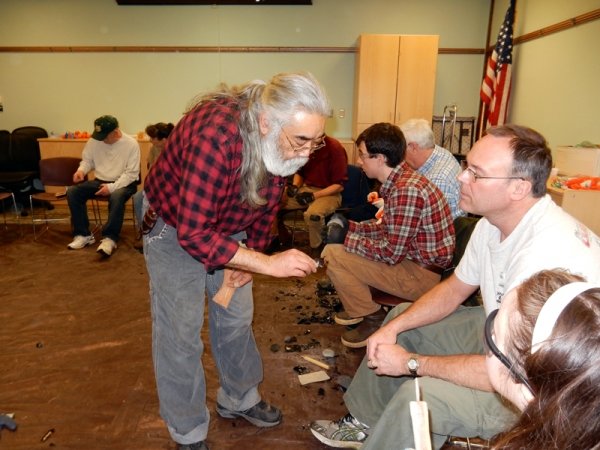 Instructor Harry Oda examines an arrowhead (in progress) made by student Rod Pierson during a recent flint knapping class at the Key Center Library. Photo by Karen Lovett, KP News
Instructor Harry Oda examines an arrowhead (in progress) made by student Rod Pierson during a recent flint knapping class at the Key Center Library. Photo by Karen Lovett, KP News
In January, master flint knapper, Harry Oda, presented a free, hands-on flint knapping workshop to a group of 16 in the Brones Room at the Key Peninsula Library. The students ranged in age from 11 to 80, and used materials from a lapidary shop –– some imported from Oregon and others from “four tons of rock in my backyard,” Oda said.
With a tarp on the floor to catch tailings, Oda taught students to abrade, flake, notch, to use percussion and pressure flaking and to see the positive and negative in their work as they made saws, blades, arrowheads or projectile points.
“The object is to get rid of the mass. Imagine a line, a plane through the middle. Put your point on the thick end, and notch on the thin end –– less work,” Oda said. He helped with advice too, like the “right hand is the same angle and the left hand is the changed angle.”
Oda peppered the experience with historical references to tribes and the Lewis and Clark expedition from 1803 to 1806.
He said that natives traded from The Dalles, Ore. up and down the Columbia River and along the northwest coast for 8,000 to 9,000 years.
“Ninety-five percent of the knapping was done by women,” Oda said. “They made functional things.” He said that Neanderthals in Eastern Europe had been flint knapping quartzite from 90,000 to 60,000 years ago to make stone and surgical implements.
There was obsidian, agate, jasper and flint –– all molded with hammer stone, leather, copper tubing,and a file or rasp. Safety equipment included gloves, safety glasses and lots of bandages. “Obsidian can be sharpened down to one glass molecule, 500 times sharper than steel,” Oda said
Chris Bronstad, a teacher at Key Peninsula Middle School, had brought Oda into his classroom for a demonstration. With Oda being “very popular,” Bronstad suggested to librarian, Rosina Vertz, that the community would attend a hands-on experience. Bronstad said he enjoyed the “expressions of delight in their accomplishment and their creativity.”
Oda, a graduate of Washington State University, studied under Don Crabtree, “the flint knapper of all time.” Oda holds doctorate degree in archaeology and teaches at Clover Park College. He has also taught at Pierce and Bellevue Community College.
As a flint knapper for 24 years, Oda who lives in Lakewood, said if he is invited, he will return for another workshop on traditional toolmaking –– which he jokingly referred to as “Rock Abuse 101.”
Bronstad brought samples of his own flint knapping points and blades to show the students.
“You can make these,” he said.
First-time student John Thompson (from Longbranch) said he “was hoping my neolithic, paleolithic self would come back. But it doesn’t work that way. You have to work at it.”
Eleven-year-old Elizabeth Pierson, from Home, had one word to describe the experience of making her first arrowhead: “Proud.”
By the looks on all the faces, it was a great Friends of the Library function.
UNDERWRITTEN BY THE FUND FOR NONPROFIT NEWS (NEWSMATCH) AT THE MIAMI FOUNDATION, THE ANGEL GUILD, ADVERTISERS, DONORS AND PEOPLE WHO SUPPORT INDEPENDENT, NONPROFIT LOCAL NEWS